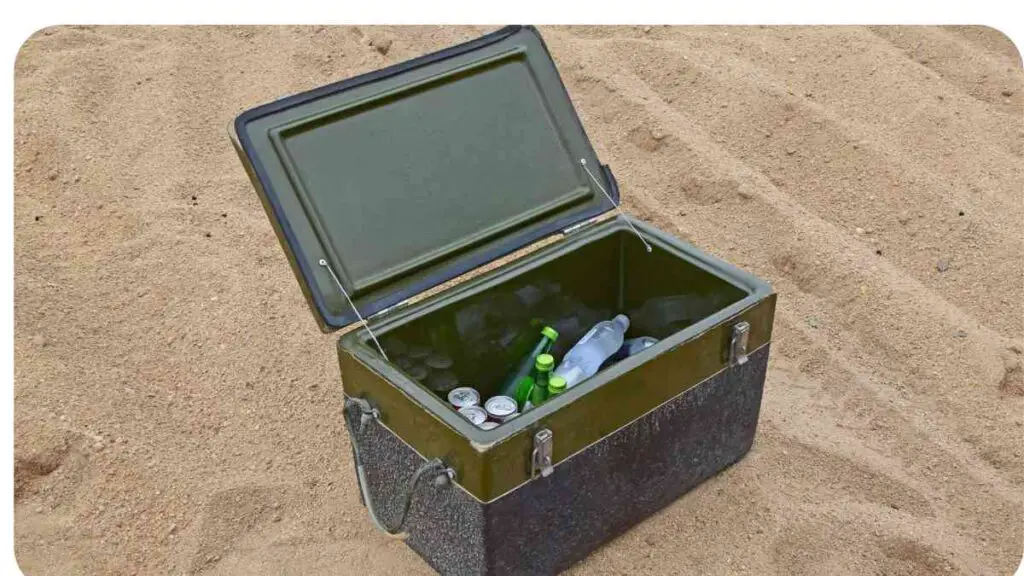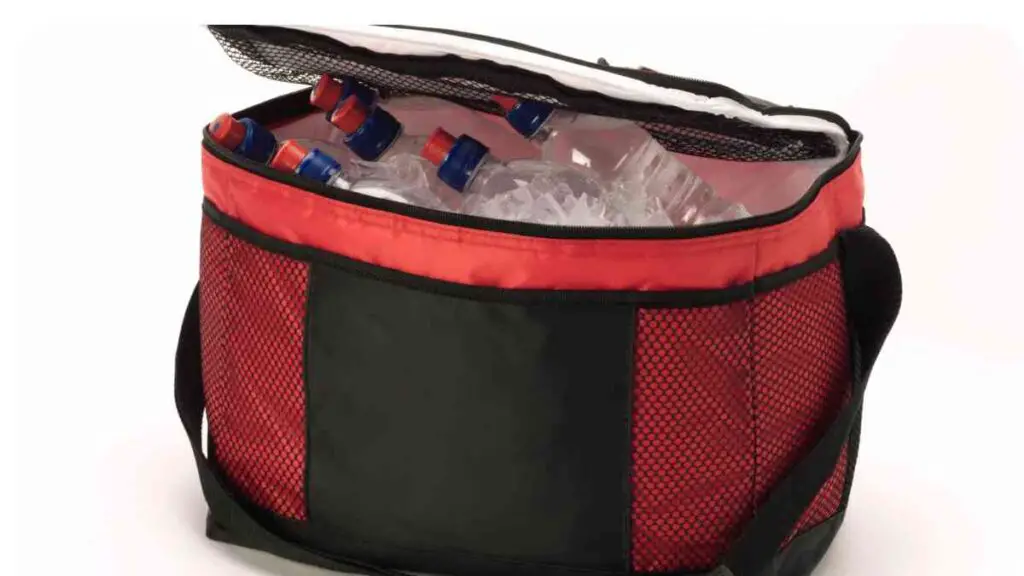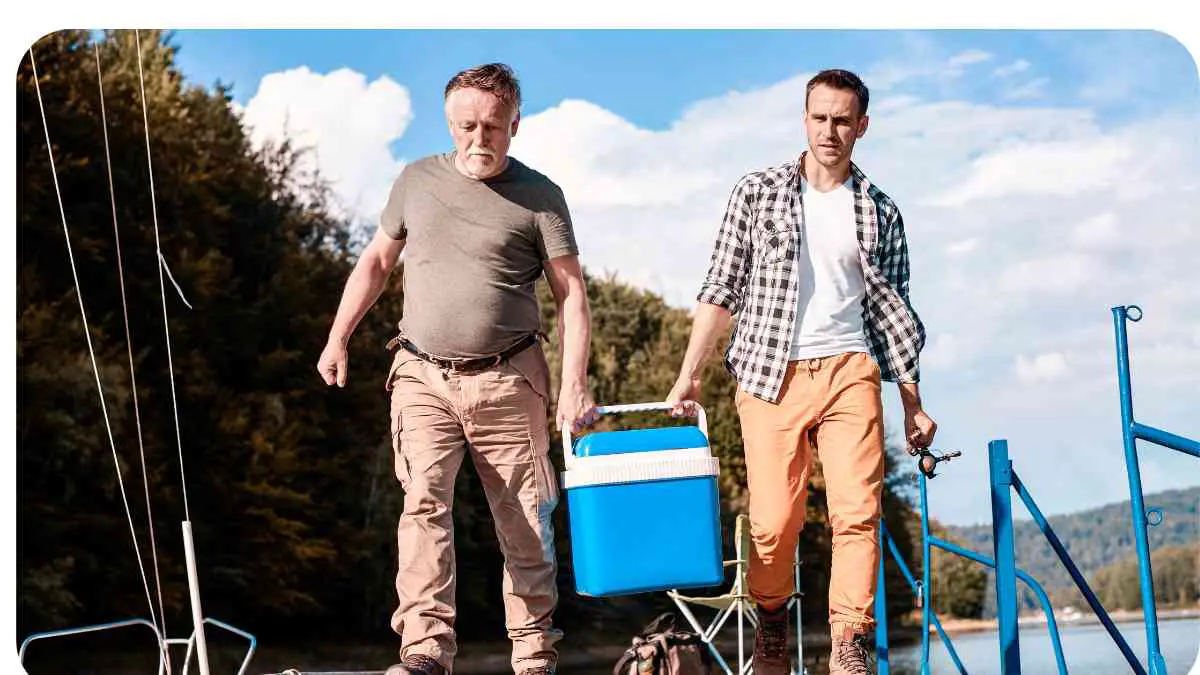Whether you’re embarking on a weekend camping adventure or a week-long backcountry expedition, one thing remains crucial: keeping your perishables fresh and your drinks cold. That’s where the remarkable efficiency of Yeti coolers comes into play.
As a seasoned camper with a penchant for outdoor explorations, I’ve come to rely on my Yeti cooler’s superior performance. In this guide, I’ll share my expertise on how to extract the maximum cooling potential from your trusty Yeti companion.
| Takeaway |
| Understand the science behind cooler efficiency. |
| Choose the right Yeti cooler model for your needs. |
| Pre-cool your cooler and use high-quality ice packs. |
| Organize contents using strategic layering techniques. |
| Consider block ice and dry ice for extended trips. |
| Maintain your cooler by draining water and cleaning it. |
| Utilize shading, minimize lid openings, and consider ambient temperature. |
| Learn from real-life case studies and experienced campers. |
| Enhance efficiency with DIY accessories and eco-friendly practices. |
| Compare Yeti with other cooler brands for informed choices. |
| Prioritize cooler efficiency for enjoyable camping experiences. |
Understanding Cooler Efficiency
Before we delve into the nitty-gritty details, let’s grasp the fundamental concept of cooler efficiency. At its core, cooler efficiency is the art of maintaining low temperatures while conserving ice. A Yeti cooler, with its cutting-edge technology and rugged design, offers a canvas for this efficiency masterpiece.
“When it comes to camping gear, having the right equipment is key to a successful trip. Explore ‘The Best Camping Tents’ here for your next adventure.”
The Science Behind Yeti Coolers

Yeti coolers are a blend of advanced engineering and practical innovation. The secret lies in their roto-molded construction, which ensures exceptional insulation. The walls of a Yeti cooler are designed with thick insulation foam that prevents heat exchange, effectively trapping the cold inside. But how do you harness this science to your advantage?
Factors Affecting Cooling Efficiency
Several factors play a pivotal role in dictating how efficiently your Yeti cooler performs. Let’s break down these factors and explore how to optimize them:
“Cooking over an open fire is part of the camping experience. Discover ’15 Delicious Campfire Recipes’ here for mouthwatering campfire meal ideas.”
Ambient Temperature
Imagine this: you’re camping in the scorching summer heat. Your cooler is exposed to direct sunlight. What happens? Heat infiltration. To counter this, always keep your cooler in the shade. If natural shade is sparse, consider using a reflective blanket to shield it from the sun’s relentless rays.
Insulation Quality
The quality of insulation can make or break your cooler’s efficiency. Yeti coolers, with their pressure-injected commercial-grade polyurethane foam, are designed for insulation excellence. But remember, the more you open your cooler, the harder it has to work to maintain the chill. Keep the lid closed, and only access it when necessary.
“Planning the perfect camping trip requires attention to detail. Check out ‘The Ultimate Camping Guide’ here to ensure your next adventure is well-organized.”
Cooler Packing
How you pack your cooler matters. The way you layer your items and position your ice packs can impact airflow and temperature distribution. To facilitate even cooling, start with a layer of ice packs, followed by your pre-chilled items. Place another layer of ice packs on top. This strategic arrangement maintains uniform coldness throughout the cooler.
Choosing the Right Yeti Cooler Model
Yeti offers a range of cooler models, each tailored to specific needs. Let’s briefly explore two prominent series:
Yeti Tundra Series
The Tundra series embodies robustness and versatility. It’s perfect for extended camping trips and group outings. With its impressive ice retention capabilities, this series is an adventurer’s dream.
Yeti Hopper Series
On the other hand, the Hopper series excels in portability. Its soft-shell design and leakproof zipper make it ideal for day trips and excursions. However, remember that its compact size might compromise ice retention compared to the Tundra series.
“Having the right camping gear can make or break your trip. Find the ‘Best Camping Gear for Every Type of Trip’ here and be prepared for any adventure.”
Stay tuned for the next response to continue the article and add relevant tables where needed (CT).
Preparing Your Cooler for Efficiency
Now that you understand the core principles of cooler efficiency, let’s dive into the practical steps to optimize your Yeti cooler’s performance:
Pre-Cooling
Before loading your cooler with perishables, pre-cool it by placing a sacrificial bag of ice inside for a few hours. This creates a chill foundation that enhances the overall cooling process.
Using Ice Packs
Invest in high-quality ice packs. These efficient cooling agents provide consistent low temperatures without the mess of melting ice. Position them strategically within your cooler for maximum effect.
Organizing Contents
Efficiency also hinges on organization. Group items that you’ll need together in separate bags or containers. This minimizes the need to rummage through the cooler, reducing heat infiltration.
Smart Packing Strategies
One of the keys to maximizing your Yeti cooler’s efficiency is employing smart packing techniques. Think of your cooler as a puzzle – each item has its designated place.
Layering Technique
Much like constructing a layered cake, start with a base layer of ice packs. This creates an insulating barrier between the cooler’s bottom and the contents. Place your pre-chilled food and beverages on top, ensuring they’re snugly packed to minimize air gaps.
Proper Food and Beverage Placement
Strategically place items that you’ll access frequently at the top. This prevents unnecessary opening of the cooler, preserving the cold air inside. Also, keep raw meats in sealed bags to prevent cross-contamination.
And now, let’s delve into how to extend ice retention for prolonged trips:
“Safety is paramount when camping in the USA. Learn ‘How to Stay Safe While Camping’ here with expert advice to ensure a secure and enjoyable experience.”
Extending Ice Retention
Ice retention is the holy grail of camping cooler success. Follow these tips to make your ice last longer:
Block Ice vs. Cubed Ice
For extended outings, consider using block ice. It melts slower than cubed ice and maintains a consistent cold temperature. Complement it with smaller cubed ice for rapid cooling of drinks and quick-access items.
Dry Ice Considerations
If you’re planning a week-long adventure, dry ice can be a game-changer. It’s colder than regular ice and sublimates (turns from solid to gas) without leaving behind a watery mess. However, handle dry ice with care and ensure proper ventilation.
Stay tuned for the next response to continue the article and introduce some real-world tips and examples.
Maintenance and Care
To ensure consistent efficiency from your Yeti cooler, regular maintenance is key. Here’s how to keep it in tip-top shape:
Draining Excess Water
As ice melts, it’s crucial to drain the accumulated water. Excess water can accelerate ice melting and compromise cooling performance. Make sure to tilt the cooler periodically to allow water to escape.
Cleaning and Drying
After your camping escapade, give your cooler a thorough cleaning. Use mild soap and water to wipe down the interior and exterior. Ensure it’s completely dry before storing it to prevent mold and mildew growth.
Field-Tested Tips from Experienced Campers
As someone who’s spent countless nights under the stars, I’ve accumulated a trove of practical tips for cooler efficiency. Let me share some tried-and-true advice:
Campsite Shading
Choosing your campsite strategically can make a world of difference. Look for natural shading from trees or rocks to keep your cooler away from direct sunlight.
Minimizing Cooler Opening
Opening the cooler frequently releases cold air and lets warm air in. Plan your grabs wisely to minimize unnecessary opening. Consider using clear plastic bins to store frequently accessed items on top.
Utilizing Ambient Temperature
Did you know that the temperature around you can play a role in cooler efficiency? If the nights are chilly, take advantage by leaving your cooler outside during the night. It’ll act as an extra refrigerator.
Case Studies: Yeti Coolers in Action
Let’s explore a couple of real-life scenarios to illustrate the effectiveness of Yeti coolers:
Weekend Camping Trip
During a recent weekend camping trip, my Yeti Tundra cooler kept our provisions chilled to perfection. With careful packing and minimal lid openings, we enjoyed refreshing drinks and fresh meals even on the third day.
Extended Backcountry Expedition
On a week-long backcountry adventure, I opted for the Yeti Tundra’s larger model. With a combination of block ice and dry ice, my perishables remained cool for the entire trip. It was a game-changer for our group’s morale and meal quality.
Stay tuned for the next response to continue the article with DIY cooler accessories and eco-friendly practices, as well as comparisons with other brands.
DIY Cooler Accessories for Enhanced Efficiency

Elevate your cooler game with some DIY accessories that amplify efficiency:
DIY Insulation Enhancements
If you’re seeking to further improve insulation, consider adding reflective foil insulation panels to the interior lid. These panels act as a radiant barrier, minimizing heat transfer.
Solar-Powered Cooler Fans
Harness the power of the sun to keep your cooler cool. Solar-powered fans can be affixed to your cooler’s lid, promoting airflow and reducing internal temperatures.
Eco-Friendly Practices
As responsible adventurers, it’s our duty to minimize our environmental impact. Here’s how you can make your cooler usage more eco-friendly:
Reusable Ice Packs
Opt for reusable ice packs over single-use ones. They’re not only better for the environment, but they also save you money in the long run.
Responsible Disposal of Cooler Contents
When your camping journey comes to an end, ensure you dispose of any leftover perishables responsibly. Compost organic waste and properly bag any trash to prevent littering.
Comparing Yeti to Other Cooler Brands
It’s only natural to wonder how Yeti stacks up against its competitors. Let’s briefly compare Yeti to a couple of other popular cooler brands:
Yeti vs. Pelican
Both Yeti and Pelican offer impressive insulation, but Yeti’s range of sizes and models caters to a broader audience. Pelican excels in ruggedness and durability, making it ideal for extreme conditions.
Yeti vs. RTIC
RTIC coolers offer similar performance to Yeti at a more budget-friendly price point. While they might not have all the premium features, they’re a great alternative for those seeking affordability without compromising too much on quality.
Final Thoughts and Takeaways
In the world of camping, a high-performing cooler can be the difference between enjoying delicious meals and suffering from spoilt food. Yeti coolers have earned their reputation for a reason – they’re efficient, durable, and designed with the camper’s needs in mind.
By understanding the science behind cooler efficiency, employing smart packing techniques, and implementing field-tested tips, you can make the most out of your Yeti cooler on every camping trip. Remember, cooler efficiency isn’t just about keeping things cold; it’s about making memories that last a lifetime.
Conclusion
As we conclude this guide, I hope you’ve gained valuable insights into maximizing your Yeti cooler’s efficiency. By combining science, experience, and a touch of DIY ingenuity, you can embark on your next camping adventure fully equipped to savor every moment without worrying about the state of your provisions. Happy camping, fellow adventurers!
Further Reading
For more in-depth information on maximizing your cooler’s efficiency and getting the most out of your Yeti cooler, check out the following resources:
- Maximizing Ice Retention – Yeti Short Description: Explore Yeti’s official guide to understanding and enhancing ice retention in your cooler.
- Yeti Ice Retention Tips Short Description: Discover expert tips directly from Yeti on how to maintain optimal ice retention in your cooler.
- How to Pack a Cooler – Fresh Off The Grid Short Description: Learn practical techniques for packing your cooler efficiently to make the most of your outdoor adventures.
FAQs
Here are some common questions related to maximizing your Yeti cooler’s efficiency, along with their answers:
How do I choose the right size Yeti cooler for my camping trip?
Selecting the appropriate Yeti cooler size depends on the duration and size of your trip. Consider the number of people, the length of the journey, and the available space in your vehicle. Yeti offers a range of models catering to various needs.
Can I use regular ice with my Yeti cooler?
Yes, you can use regular cubed or block ice with your Yeti cooler. However, keep in mind that the quality of ice and how it’s packed will affect the cooler’s efficiency. Using high-quality ice and employing proper packing techniques will yield the best results.
How can I extend the ice retention of my Yeti cooler during a long camping trip?
To extend ice retention on extended trips, consider using a combination of block ice and dry ice. Block ice melts slower and dry ice maintains lower temperatures, enhancing overall cooling efficiency. Remember to handle dry ice with care and ensure proper ventilation.
What’s the best way to organize the contents of my cooler for maximum efficiency?
To optimize cooler efficiency, utilize a layered packing approach. Start with a layer of ice packs at the bottom, followed by pre-chilled items. Place frequently accessed items on top to minimize lid openings. Proper organization ensures even temperature distribution.
Can I use my Yeti cooler as a freezer?
While Yeti coolers are designed for ice retention, they are not true freezers. However, with the right combination of ice and packing, you can achieve freezing temperatures for short periods. Yeti’s insulation will help maintain lower temperatures compared to traditional coolers.

I’m Hellen James, and I am a camping enthusiast. I’ve been camping since I was a kid and have always loved it the fresh air, the beautiful scenery, and the great outdoors. In fact, it’s one of my favorite things to do in the summer!


